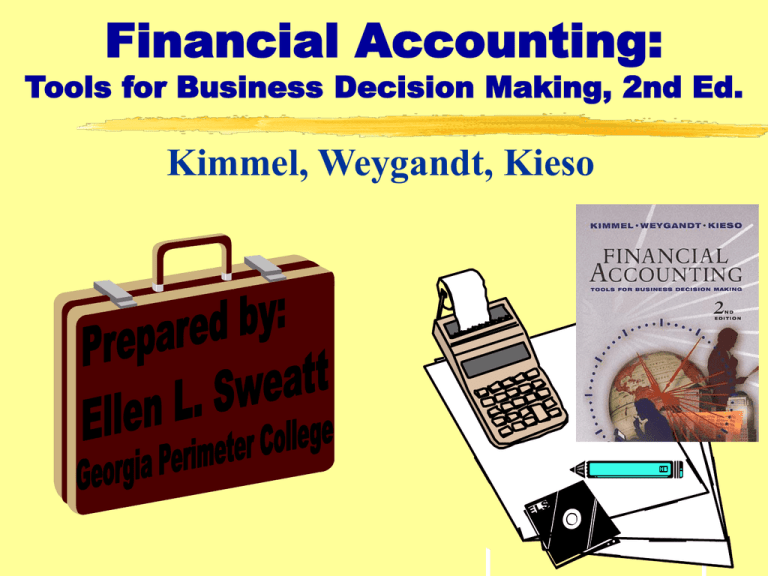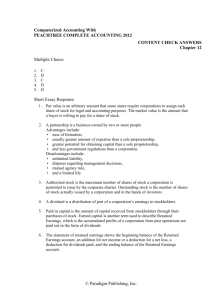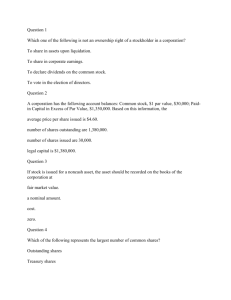
Financial Accounting:
Tools for Business Decision Making, 2nd Ed.
Kimmel, Weygandt, Kieso
1
Chapter
11
`
Chapter 11
Reporting and Analyzing
Stockholders’ Equity
After studying Chapter 11, you should
be able to:
Identify and discuss the major
characteristics of a corporation.
Record the issuance of common
stock.
Explain the accounting for purchase
of treasury stock.
Differentiate preferred stock from
common stock.
3
Chapter 11
Reporting and Analyzing
Stockholders’ Equity
After studying Chapter 11, you should
be able to:
Prepare the entries for cash dividends
and stock dividends.
Identify the items that affect retained
earnings.
Prepare a comprehensive
stockholders' equity section.
Evaluate a corporation's dividend and
earnings performance from a
stockholder's perspective.
4
Corporation
Possess legal entity
Created by law
Has most of the rights and privileges
of a person
Classified by purpose and ownership
Purpose - profit or nonprofit
Ownership - publicly or privately
held
5
Publicly Held Corporation...
May have thousands of
stockholders and its stock is
regularly traded on national
securities markets.
6
Privately Held Corporation...
May have few stockholders and
does not offer its stock for sale to
general public.
7
Characteristics of a Corporation
Separate legal existence
Limited liability of stockholders
Transferable ownership rights
Ability to acquire capital
Continuous life
Corporation management
Government regulations
Additional taxes
8
Separate Legal Existence
Separate and distinct from
owners.
Acts under its own name.
May buy, own, sell property;
borrow money; enter into legally
binding contracts; may sue or be
sued; pays its own taxes.
Owners (stockholders) cannot
bind corporation unless owners
are agents of the corporation.
9
Limited Liability of Stockholders
Creditors have recourse only to corporate
assets to satisfy claims.
Liability of stockholders limited to
investment in
corporation.
Creditors have no
legal claim on
personal assets
of owners unless
fraud has occurred.
10
Transferable Ownership Rights
Ownership evidenced by shares of stock
Transfer of ownership among stockholders
has no effect on corporation’s operating
activities or assets,
liabilities and total
stockholders' equity.
Corporation does not
participate in transfer
of ownership rights
after original sale.
11
Ability to Acquire Capital
Limited liability of stockholders
coupled with transferable ownership
rights make it easy
to raise capital.
12
Continuous Life
Life of corporation stated in charter may be perpetual or limited to specific
number of years (can be extended).
Corporation is separate
legal entity, thus life
not affected by
withdrawal, death,
or incapacity of
stockholder.
13
Forming a Corporation
A corporation can operate in
various states (must have a
license from each state in
which it does business) but can
be incorporated in only one
state.
14
Corporation Management
The corporation establishes by-laws
upon receipt of its charter from the
state of incorporation.
Stockholders manage corporation
indirectly through board of directors.
Board of directors
formulates operating policies
selects officers to execute policy
and to perform daily management
functions.
15
Illustration 11-1
Corporate
Organization
Chart
Page 513 of text
Additional Taxes
Corporations pay federal and state income
taxes.
Stockholders pay
taxes on cash
dividends.
Corporate income
is taxed twice.
18
Stockholder Rights
Once chartered, the corporation
sells stock .
If only one class of stock - called
common stock.
Ownership rights specified in the
articles of incorporation or by-laws.
Proof of stock ownership is a
printed or engraved form known as
stock certificate.
19
Illustration 11-3
Illustration 11-4
Stock Certificate Shows...
name of the corporation
stockholder's name
class and special features of the
stock
the number of shares owned
the signatures of
duly authorized
corporate officials.
21
Questions in Issuing Stock...
How many shares should be
authorized for sale?
How should the stock be issued?
At what price should the shares be
issued?
What value should be assigned to
the stock?
22
Authorized Stock...
Maximum amount of stock a
corporation is allowed to sell as
authorized by corporate charter.
Outstanding Stock...
Number of shares of issued stock
that are being held by stockholders.
23
Corporations Can Issue Stock...
Directly to investors (typical in
privately held corporations).
Indirectly through an investment
banking firm (customary with
publicly held corporations).
24
Factors Involved in Setting
Price of Stock...
Company's anticipated future
earnings
Its expected dividend rate per
share
Its current financial position
Current state of the economy
Current state of the securities
market
25
Par Value Stock...
Is capital stock that has been
assigned an arbitrary value per
share in the corporate charter.
Is usually low because some
states levy a tax on the corporation
based on par value.
The legal capital per share that
must be retained in the business.
26
No-Par Value Stock...
Capital stock that has not been
assigned a value per share in the
corporate charter.
Stated Value of No-Par Stock
Amount per share assigned by the
board of directors to no-par stock.
Par Value and Stated Value have NO
relationship to market value.
27
Relationship of Par and No-Par
Value to Legal Capital
Illustration 11-5
Stock
Par value
Legal Capital Per
Share
Par value
No-par value with Stated value
stated value
No-par value
Entire proceeds
without stated
value
28
Stockholders’ Equity Section of
a Corporation’s Balance Sheet...
Two Parts:
Paid-in (contributed) capital
Retained earnings (earned
capital).
29
Paid-in Capital...
Amount paid to corporation by
stockholders for shares of
ownership.
Retained Earnings...
Earned capital held for future
use in the business.
30
Accounting for
Common Stock Issues
The issue of common stock affects
only paid-in capital accounts.
When the issuance of common
stock for cash is recorded, the par
value of the shares is credited to
Common Stock.
The portion of the proceeds above
or below par value is recorded in a
separate paid-in capital account.
31
Issuing Stock at Par
Assume Hydro-Slide, Inc., issues
1,000 shares of $1 par value of
common stock at par for cash.
Cash
Common Stock
1,000
1,000
32
Issuing Stock Above Par
If Hydro-Slide, Inc., issues an additional
1,000 shares of the $1 par value common
stock for cash at $5 per share, the entry is:
Cash
5,000
Common Stock
1,000
Paid-in Capital in
Excess of Par Value
4,000
33
Hydro-Slide, Inc.
Balance Sheet (partial)
Stockholders' equity
Paid-in capital
Common stock
Paid-in capital in excess of par
Total paid-in capital
Retained earnings
Total stockholders' equity
Illustration 11-6
$ 2,000
4,000
$ 6,000
27,000
$33,000
Mead, Inc.
Balance Sheet (partial)
Stockholders' equity
Paid-in capital
Common stock,$5par value,
100,000 shares issued and
outstanding
Retained Earnings
Total stockholders’ equity
Illustration 11-7
$ 500,000
200,000
$ 700,000
BEFORE TREASURY STOCK TRANSACTION
Treasury Stock...
Is a corporation's own stock
that has been issued
fully paid for
reacquired by the corporation
held in its treasury for future
use.
36
Corporations Acquire
Treasury Stock to...
Reissue shares to officers and employees
under bonus and stock compensation plans.
Increase trading of company's stock in
securities market in hopes of enhancing
market value.
Have additional shares available for use in
acquisition of other companies.
Reduce number of shares outstanding
thereby increasing earnings per share.
Prevent a hostile takeover.
37
Purchase of Treasury Stock
On February 1, 2001, Mead acquires
4,000 shares of its stock at $8 per
share.
Treasury Stock
Cash
32,000
32,000
38
Treasury Stock
The Treasury Stock account would increase
by the cost of the shares purchased $32,000.
The original paid-in capital account,
Common Stock, would not be affected
because the number of issued shares does
not change.
Treasury stock is deducted from total paidin capital and retained earnings in the
stockholders' equity section of the balance
sheet.
39
Mead, Inc.
Balance Sheet (partial)
Stockholders' equity
Paid-in capital
Common stock,$5par value,
100,000 shares issued and
96,000 outstanding
Retained Earnings
Total stockholders’ equity
Less: Treasury Stock
Total stockholders’ equity
Illustration 11-8
$ 500,000
200,000
700,000
32,000
$ 668,000
AFTER TREASURY STOCK TRANSACTION
Preferred Stock...
Capital stock that has contractual
preferences over common stock in
certain areas.
Dividends
Assets in the event of liquidation
Preferred stockholders do not
have voting rights.
41
Preferred Stock
Assume Corporation issues 10,000 shares of
$10 par value preferred stock for $12 cash per
share.
Cash
120,000
Preferred Stock
Paid-in Capital in Excess
of Par Value--Preferred Stock
100,000
20,000
(Preferred stock may have either a par value
or no-par value.)
42
Dividend Preferences
Preferred stockholders have the right to
share in the distribution of corporate
income before common stockholders.
The first claim to dividends does not
guarantee dividends.
43
Cumulative Dividend...
Is a feature of preferred stock
entitling the stockholder to receive
current and unpaid prior-year
dividends before common
stockholders receive any dividends.
44
Dividends in Arrears...
Are preferred dividends that were
scheduled to be declared but were not
declared during a given period.
Are not a liability. No liability exists
until a dividends is declared by board
of directors.
Must be disclosed in the notes to the
financial statements.
45
Illustration 11-9
Dividends in Arrears
Scientific-Leasing has 5,000 shares of 7%, $100
par value cumulative preferred stock
outstanding.
The annual dividend is $35,000 (5,000 x $7 per
share).
Dividends are 2 years in arrears
Dividends in arrears ($35,000 x 2 years)
Current-year dividends
Total preferred dividends
$ 70,000
35,000
$105,000
46
Liquidation Preference
Is a feature that gives preferred
stockholders preference to
corporate assets in the event of
liquidation.
47
Dividend...
Is a distribution by a corporation to its
stockholders on a pro rata basis.
Pro rata means that if you own 10% of
the common shares, you will receive
10% of the dividend.
Dividend forms:
cash
property
script (promissory note to pay cash)
stock.
48
Cash Dividend
Is a pro rata distribution of cash
to stockholders.
A corporation must have
3
things to pay cash
dividends:
Retained earnings
Adequate cash
Declared dividends
49
Cash Dividend
In many states, payment of dividends
from legal capital is illegal.
Payment of dividends from paid-in
capital in excess of par is legal in
some states.
Payment of dividends from retained
earnings is legal in all states.
Companies are frequently constrained
by agreements with lenders to pay
dividends only from retained earnings.
50
Entries for Cash Dividends
Three dates are important in
connection with dividends:
the declaration date
the record date
the payment date
Month a nd ye a r
00
00
00
00
00
00
00
00
00
00
00
00
00
00
00
00
00
00
00
00
00
00
00
00
00
00
00
00
00
00
00
00
00
00
51
Monday
Tue sday
Wedne sday
Thursday
Friday
Saturday
Sunday
00
The Declaration Date...
Is the date the board of directors declares
the cash dividend.
Commits the corporation to a binding legal
obligation that cannot be rescinded.
On December 1, 2001 the directors of Media
General declare a $.50 per share cash dividend on
100,000 shares of $10 par value common stock.
The dividend is $50,000 (100,000 x $.50).
12/1
Retained Earnings
Dividends Payable
50,000
50,000
52
The Record Date...
The date ownership of the outstanding
shares is determined for dividend purposes.
12/1
No Entry Necessary.
The Payment Date...
The date dividend checks are mailed.
January 20 is the payment date for Media
General.
1/20 Dividends Payable
Cash
50,000
50,000
53
A Stock Dividend...
Is a pro rata distribution of the
corporation's own stock to stockholders.
Is paid in stock.
Results in a decrease in retained earnings
and an increase in paid-in capital.
Does not decrease total stockholders'
equity or total assets.
Is often issued by companies that do not
have adequate cash to issue a cash
dividend.
54
Stock Dividends
You have a 2% ownership interest in
Cetus Inc., owning 20 of its 1,000 shares
of common stock.
In a 10% stock dividend, 100 shares
(1,000 x 10%) of stock would be issued.
You would receive two shares (2% x 100),
but your ownership interest would remain
at 2% (22 /1,100).
You now own more shares of stock, but
your ownership interest has not changed.
55
Reasons for Stock Dividends
To satisfy stockholders' dividend
expectations without spending cash.
To increase marketability of its stock by
increasing number of shares outstanding
and decreasing market price per share.
To emphasize that a portion of
stockholders' equity has been
permanently reinvested in business and
is unavailable for cash dividends.
56
Stock Dividends
A small stock dividend (less than
20%-25% of the corporation's issued
stock) is recorded at the fair market
value per share.
A large stock dividend (greater than
20%-25% of the corporation's issued
stock) is recorded at par or stated
value per share.
57
Stock Dividends
Medland Corporation has $300,000 in
retained earnings and declares a 10% stock
dividend on its 50,000 shares of $10 par
value common stock.
The current fair market value of the stock
is $15 per share.
Retained Earnings
75,000
Common Stock Dividends
50,000
Distributable
Paid-in Capital in Excess
25,000
of Par Value
58
Stock Split...
Is the issuance of additional shares of
stock to stockholders accompanied by:
A reduction in the par or stated value.
An increase in number of shares.
A stock split does not have any effect on
total paid-in capital, retained earnings, and
total stockholders' equity
59
Stock Split
Because a stock split does not
affect the balances in
stockholders' equity accounts, it
is not necessary to journalize a
stock split.
60
Retained Earnings...
Is net income that is retained in
the business.
The balance in retained earnings
is part of the stockholders' claim
on the total assets of the
corporation.
Retained earnings does not
represent a claim on any specific
asset.
61
Deficit...
Is a debit balance in retained
earnings and is reported as a
deduction in the stockholders'
equity section of the balance
sheet.
62
Retained Earnings Restrictions...
Are legal, contractual or
voluntary circumstances that
make a portion of retained
earnings currently unavailable for
dividends.
63
Illustration 11-18
Kmart, Inc.
Balance Sheet (Partial)
(in millions)
Stockholders' equity
Common stock, $.01 par value;
1,500,000,000 shares authorized -250,000,000; 493,358,504
shares issued
$
Capital in excess of par value
Retained earnings
Total stockholders' equity
$
493
1,667
3,819
5,979
64
Illustration 11-19
The Payout Ratio =
TOTAL CASH DIVIDENDS DECLARED ON COMMON STOCK
NET INCOME
… measures the percentage of earnings
distributed in the form of cash
dividends to common stockholders.
65
Illustration 11-19
The Dividend Yield =
DIVIDENDS DECLARED PER SHARE OF COMMON STOCK
STOCK PRICE AT END OF YEAR
…reports the rate of return an
investor earned from dividends.
66
Illustration 11-21
Earnings Per Share =
NET INCOME - PREFERRED STOCK DIVIDENDS
AVERAGE COMMON SHARES OUTSTANDING
...measures the net income earned on
each share of common stock.
67
Illustration 11-21
Price-Earnings Ratio =
MARKET PRICE PER SHARE OF STOCK
EARNINGS PER SHARE
In order to make a meaningful
comparison of earnings across firms,
use the price-earnings ratio.
The price-earnings ratio reflects the
investors' assessment of a company's
future earnings.
68
Return on Common
Stockholders’ Equity Ratio =
Illustration 11-23
NET INCOME -PREFERRED STOCK DIVIDENDS
AVERAGE COMMON STOCKHOLDERS’ EQUITY
...measures the profitability from
the stockholders’ point of view.
69
COPYRIGHT
Copyright © 2000, John Wiley & Sons, Inc. All rights reserved.
Reproduction or translation of this work beyond that permitted in
Section 117 of the 1976 United States Copyright Act without the
express written permission of the copyright owner is unlawful.
Request for further information should be addressed to the
Permissions Department, John Wiley & Sons, Inc. The purchaser
may make back-up copies for his/her own use only and not for
distribution or resale. The Publisher assumes no responsibility
for errors, omissions, or damages, caused by the use of these
programs or from the use of the information contained herein.
70







